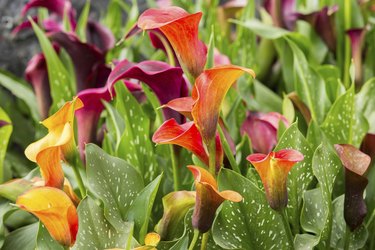
Classic white calla lilies (Zantedeschia aethiopica) and cultivars of hybrid calla lilies (Zantedeschia hybrida), which come in colors ranging from pink and cream to yellow, orange, purple and rust all grow in U.S. Department of Agriculture plant hardiness zones 8 through 10. In colder areas, you can either treat them as annuals or dig up the rhizomes to store indoors for the winter and plant them outdoors the following spring.
Digging Up Calla Rhizomes
Video of the Day
The bulblike rhizomes of calla lilies look like small potatoes. Dig the rhizomes up to store for the winter when the leaves turn yellow or are damaged by frost.
Video of the Day
To dig up rhizomes, soak the blade of a sharp knife for five minutes in a solution of 1 part household bleach to 3 parts and allow it to air-dry. Use the knife to cut off the plants' tops to about 2 inches above the soil. Use a spade or fork to carefully remove the rhizomes from the ground, taking care not to damage them.
Shake the soil off the rhizomes, rinse them, and dry them for one to three days in a room or sheltered area away from drying winds or direct sunlight.
Move calla lilies growing outdoors in pots indoors to spend their dormant season sheltered from winter cold.
Winter Storage
Fill ventilated containers or cardboard boxes with peat moss, sawdust or vermiculite and bury the dried rhizomes inside. Store them in an area that stays around 45 to 55 degrees Fahrenheit for the winter. A crawl space, unheated basement or garage are good places to store them. The temperature should never drop below freezing.
If you grow calla lilies outdoors in pots, bring the pots indoors when the first fall frost approaches. Store the pots in your house, garage or anywhere else that does not go below 50 F. The calla lilies will go dormant. Don't water them until after the last spring frost and you take the pot outside for them to begin growing again.
Winter Care and Spring Planting
Check on your rhizomes several times during winter. Discard rotten or moldy packing material and shriveled rhizomes. Cut away rotten spots with a sharp, sterile knife. Mist the packing material with water if the rhizomes look shrunken or are beginning to wrinkle.
After the danger of spring frost has passed, plant the rhizomes horizontally 3 inches deep with the growing tips facing up. Choose a spot in full sun and keep the soil moist but not soggy.
Calla Lily Warning
Calla lilies, and especially their rhizomes, produce toxic oxalic acid. If you eat any part of a calla lily, you may experience swelling and pain of your eyes, swelling and burning of your mouth, throat and tongue, nausea, diarrhea and vomiting. While this poison is not typically life-threatening, a severe reaction can kill children or pets.
If you eat any part of a calla lily and experience symptoms of poisoning call a doctor or the National Capital Poison Control Center at 1-800-222-1222. Operators at this number, which runs 24/7, will connect you with the poison control center nearest you.
White calla lily is considered invasive in some areas, so check before you plant.
- University of Minnesota Extension: Storing Bulbs and Bulb-Like Structures
- University of Illinois Extension: Calla Lilies
- Iowa State University Extension: Winter Storage of Tender Perennials
- Today's Homeowner: How to Store Tender Bulbs Over The Winter
- Missouri Botanical Garden: Zantedeschia Aethiopica
- Pacific Callas: Calla Lily Planting Guide
- White Flower Farm: Growing Guide Calla Lily
- Veseys: Calla Lily
- National Capital Poison Control Center: Poison Control Hotline
- University of Florida IFAS Extension: Disinfecting Pruning Tools
- Karen's Garden Tips: Plant Profile: Calla Lily (Zantedeschia hybrids)